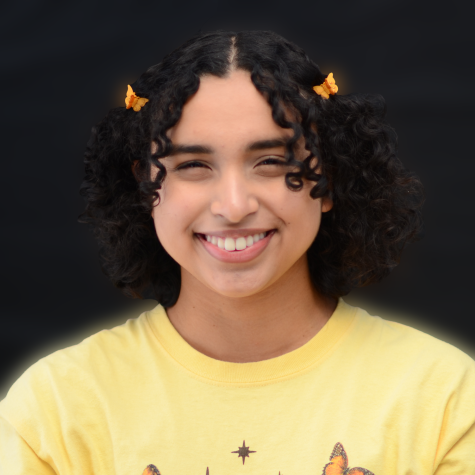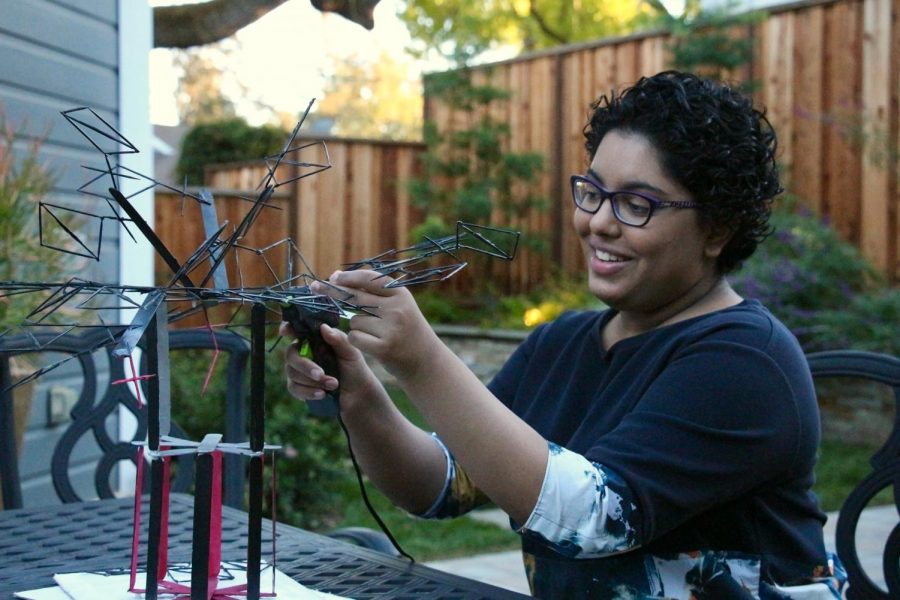Humans of Harker: Cosmic creativity
Kimi Butte enjoys exploring the world around her
“The universe is so big. There are stars out there that will live for 10 trillion years, and the universe is only 14 billion years old. Putting that into human terms, these stars have only lived for a few days of their life. There’s so much to learn, and science is always changing as we discover new things. That’s what I love about that field of science,” Kimi Butte (12) said.
Pressing the handle of her glue gun, Kimi Butte (12) attaches one last part to her newest project. She had just completed the last leaf of a tree made of toothpicks, a piece she was working on for her sculpture class that represented her growth over the past few years. After pressing the toothpick in place to let it dry, she lifts her hands carefully off the piece and checks if she needs to add any finishing touches. Satisfied, she leans back in her chair and sighs, admiring her work.
In her junior year, Kimi began taking Advanced Ceramics because she wanted to try something new. As an underclassman, she had taken many difficult classes and pushed herself to work harder, but after learning the value of mental health she decided to try a class that allowed her to utilize her creative mind. She appreciated how sculpture did not provide the same amount of stress as her other classes.
“I take a lot of STEM classes, so sculpture is a nice change of pace,” Kimi said. “It’s very relaxing, and it’s really fun. For a lot of STEM classes, there’s only one right answer, and there’s only one right way to get there. You just have to follow the steps and get the answer, but for art there’s no one right answer. It’s very open to [your own] interpretation.”
In addition to improving her artistic skills, these classes helped her become more comfortable interacting with her peers. Upper school ceramics and sculpture teacher Trish Ludovici reflects on how Kimi has developed over the years both inside and outside of the classroom.
“I saw Kimi grow in the way she interacted with her peers, the conversations that she had with them, as well as her creativity,” Ludovici said. “Sometimes she could see what other people were making and get new ideas. That’s what you want to see in a classroom, especially an art classroom—somebody taking chances and being creative.”
Aside from relieving stress, participating in these classes allowed Kimi to display a side of herself no one had seen before. She realized that she could express herself to the people around her using her creativity.
“[My favorite thing about art is] the freedom that it gives you,” Kimi said. “ It’s a way to clearly express yourself, and it’s a way of communicating that’s universal. A lot of people can understand art. Even if you don’t speak the same language, you can communicate your feelings and your emotions and your identity.”
Her curiosity for the world around her extends further than sharing her artwork with her peers. In middle school, she enjoyed watching “Cosmos: A Spacetime Odyssey” with her father, and that sparked her interest in astronomy and cosmology. She remembers how he always encouraged her to learn more about the topics she was interested in.
“My dad and I really bonded through science,” Kimi said. “[He] would always take me to Maker Faire every year. It’s this giant convention with all this new technology and cool science-based art and 3D printer. We would go to all these astrophysics talks at Stanford whenever we had time.”
Experiencing science firsthand with her father inspired her to explore areas like astronomy and cosmology in high school. Upper school physics and astronomy teacher Dr. Eric Nelson admires Kimi’s ability to take chances and work towards whatever she enjoys.
“[My favorite thing about her] is her ability to follow her interests. She took the Modern Physics class just to check it out, and she thought it was very cool and continued to follow up on it,” Dr. Nelson said. “She took summer courses in the subject and decided that astronomy has a lot of overlap, so she checked that out too. She tried something different, found it interesting and then tried to pursue that interest on her own and at Harker.”
Aside from taking new classes, she also stepped outside her comfort zone when interacting with others. Close friend Audrey Liu (12) reflects on how she has become more communicative with the people around her.
“Especially this year, she’s become very willing to interact with people. In the beginning, she used to be kind of reserved and quiet. Now, she’s not only talkative with people she knows, she has also become a lot more open about communication,” Audrey said. “She’s not afraid to speak her mind. If there’s something she really enjoys, she’ll talk about it so much that you’ll get interested in it too.”
Kimi’s ability to spread her interests by communicating with others is a testament to her own dedication to the activities she enjoys. Her curiosity for the world around her motivates her to pursue areas like astronomy and cosmology.
“The universe is so big. There are stars out there that will live for 10 trillion years, and the universe is only 14 billion years old. Putting that into human terms, these stars have only lived for a few days of their life,” Kimi said. “There’s so much to learn, and science is always changing as we discover new things. That’s what I love about that field of science.”

Shinjan Ghosh (12) is the co-editor-in-chief of the TALON Yearbook, and this is her third year on staff. This year, she hopes to provide a welcoming environment...


















![“[Building nerf blasters] became this outlet of creativity for me that hasn't been matched by anything else. The process [of] making a build complete to your desire is such a painstakingly difficult process, but I've had to learn from [the skills needed from] soldering to proper painting. There's so many different options for everything, if you think about it, it exists. The best part is [that] if it doesn't exist, you can build it yourself," Ishaan Parate said.](https://harkeraquila.com/wp-content/uploads/2022/08/DSC_8149-900x604.jpg)




![“When I came into high school, I was ready to be a follower. But DECA was a game changer for me. It helped me overcome my fear of public speaking, and it's played such a major role in who I've become today. To be able to successfully lead a chapter of 150 students, an officer team and be one of the upperclassmen I once really admired is something I'm [really] proud of,” Anvitha Tummala ('21) said.](https://harkeraquila.com/wp-content/uploads/2021/07/Screen-Shot-2021-07-25-at-9.50.05-AM-900x594.png)







![“I think getting up in the morning and having a sense of purpose [is exciting]. I think without a certain amount of drive, life is kind of obsolete and mundane, and I think having that every single day is what makes each day unique and kind of makes life exciting,” Neymika Jain (12) said.](https://harkeraquila.com/wp-content/uploads/2017/06/Screen-Shot-2017-06-03-at-4.54.16-PM.png)








![“My slogan is ‘slow feet, don’t eat, and I’m hungry.’ You need to run fast to get where you are–you aren't going to get those championships if you aren't fast,” Angel Cervantes (12) said. “I want to do well in school on my tests and in track and win championships for my team. I live by that, [and] I can do that anywhere: in the classroom or on the field.”](https://harkeraquila.com/wp-content/uploads/2018/06/DSC5146-900x601.jpg)
![“[Volleyball has] taught me how to fall correctly, and another thing it taught is that you don’t have to be the best at something to be good at it. If you just hit the ball in a smart way, then it still scores points and you’re good at it. You could be a background player and still make a much bigger impact on the team than you would think,” Anya Gert (’20) said.](https://harkeraquila.com/wp-content/uploads/2020/06/AnnaGert_JinTuan_HoHPhotoEdited-600x900.jpeg)

![“I'm not nearly there yet, but [my confidence has] definitely been getting better since I was pretty shy and timid coming into Harker my freshman year. I know that there's a lot of people that are really confident in what they do, and I really admire them. Everyone's so driven and that has really pushed me to kind of try to find my own place in high school and be more confident,” Alyssa Huang (’20) said.](https://harkeraquila.com/wp-content/uploads/2020/06/AlyssaHuang_EmilyChen_HoHPhoto-900x749.jpeg)



